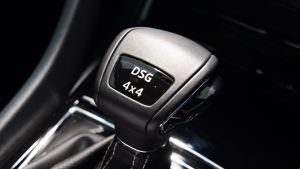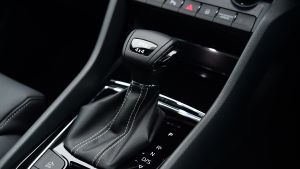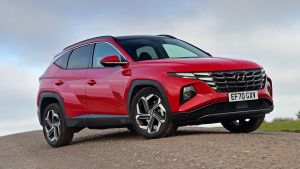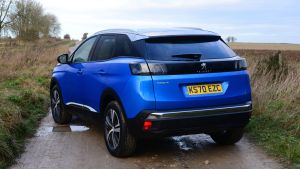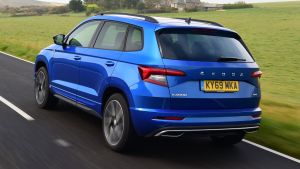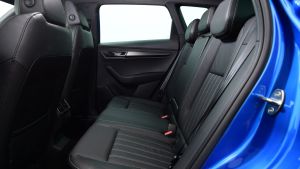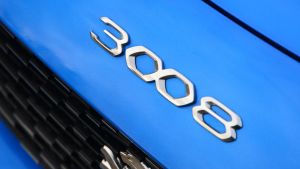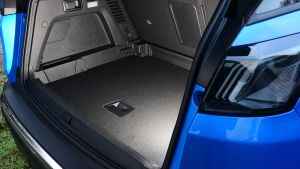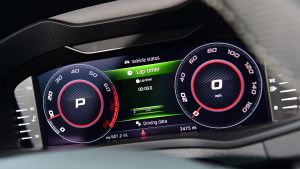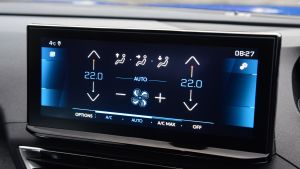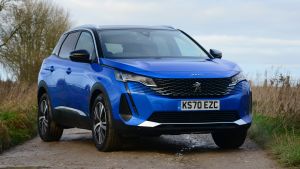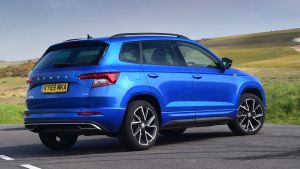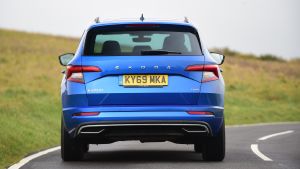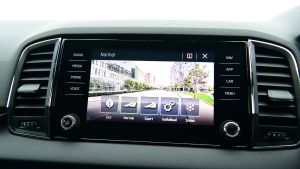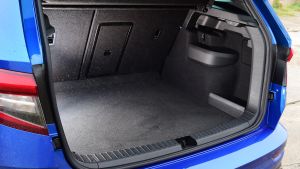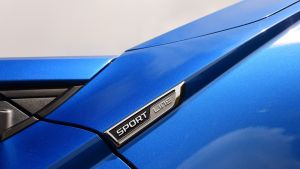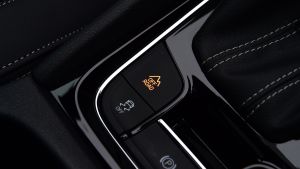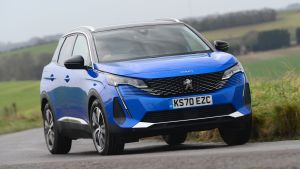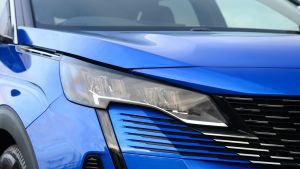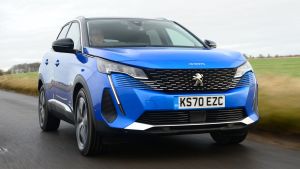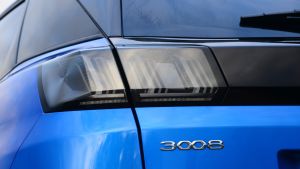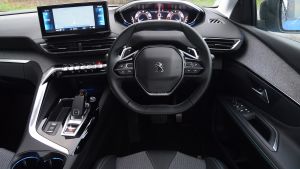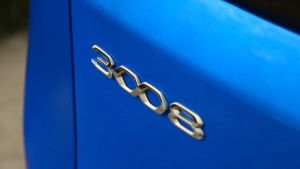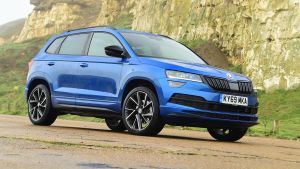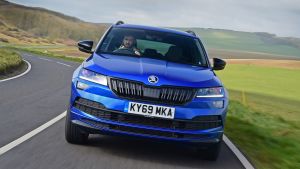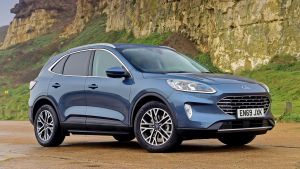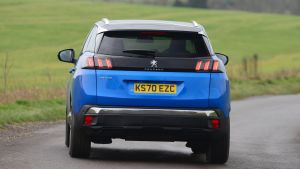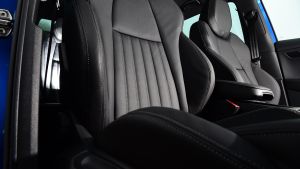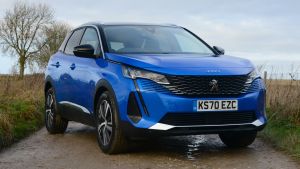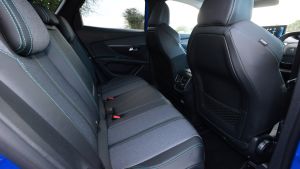Peugeot’s second-generation 3008 was the catalyst for the company‘s reinvention. It was launched back in 2016 as the car to take the French brand in a new direction – and it did just that, reimagining the model as a proper SUV and heading straight to the top of the class, with the seven-seat 5008 SUV following and a new compact 2008 launching two years ago.
Such is the pace of development in this class, though, that after almost five years on sale, the 3008 has just been facelifted. But will the updated styling, a mild tech overhaul inside and the addition of plug-in hybrid power to the range be enough to send the Peugeot back to the sharp end of the class?
- SEE MORE Best SUVs to buy 2021
To find out, we’re testing an affordable petrol automatic version in mid-spec Allure Premium trim. That means it’s lining up here against the car that knocked it off the top spot in the mid-size family SUV sector all those years ago: the Skoda Karoq.
Given the ever-widening brief cars like these versatile machines need to adapt to, it’ll be a battle fought on many fronts, so let’s see how the new Peugeot fares.
Peugeot 3008
| Model: |
Peugeot 3008 1.2 PureTech 130 EAT8 Allure Premium |
| Price: | £31,060 |
| Engine: | 1.2-litre 3cyl turbo, 129bhp |
| 0-62mph: | 9.7 seconds |
| Test economy: | 40.7mpg/9.0mpl |
| CO2: | 146g/km |
| Annual road tax: | £150 |
Updates to the 3008 include the addition of some new trim levels, including this Allure Premium version we’re testing. Fitted with the 1.2 PureTech 130 engine and the EAT8 automatic gearbox, it’s priced from £31,060.
Design & engineering
This is a facelift of the existing 3008 (the model it replaces was a big overhaul of what had come before it) so the tweaks here are subtle and focus more on looks and kit than any big engineering changes – for this 1.2-litre PureTech 130 model anyway, because the addition of a plug-in hybrid powertrain is quite an undertaking.
That means the 3008 still sits on Groupe PSA’s scalable EMP2 architecture – and why not, because this modern platform has plenty of life in it and was designed with versatility in mind from the outset.
This petrol model doesn’t feature the more sophisticated multi-link rear suspension of the Hybrid4 cars, but the standard torsion-beam rear set-up is fine. It uses MacPherson struts at the front, and the 129bhp petrol engine drives the front wheels through an eight-speed automatic gearbox.
The main focus is on updated styling to keep the 3008 looking fresh and align it more closely with the family look reinforced by more modern Peugeot models, such as the 208 supermini and 2008 SUV.
So there’s a new frameless grille, gloss black side scoops in the new bumper, and more aggressive LED headlights. At the rear, Peugeot has kept the lion’s claw lights that make the 3008 recognisable at night, but there are new scrolling indicators as well.
Inside, the layout has been updated. Peugeot’s refined i-Cockpit 2.0 made its debut on this car’s predecessor, and here it’s been tweaked again to offer even more tech. This includes a 12.3-inch digital dash panel and, on this Allure Premium-spec car, a 10-inch touchscreen. The layout might still not be to everyone’s taste, but the set-up works better here in this higher-riding SUV than some other Peugeots.
Quality is sound, with an interesting design and good use of decent materials. There are plenty of nice textures too, adding personality.
Driving
The Peugeot’s powertrain is one of its strongest suits, thanks to its willing downsized 1.2-litre engine. Even though it’s 20Nm shy of the Skoda’s torque output, combined with the EAT8 automatic gearbox’s smooth shifts, its strengths lie in cruising comfort and a relaxed driving style.
With a 9.7-second 0-62mph sprint time, it’s fast enough, and at its best when you use the engine’s mid-range flexibility. Beyond this it gets more grumbly; the engine is always audible, but the characterful three-cylinder soundtrack melts away when cruising. It’s far from droney on the motorway, while wind and road noise aren’t too loud either.
Thanks to the i-Cockpit layout, the 3008 still has a small steering wheel. The steering is quick too, but it’s sometimes easy to turn a little too aggressively because the steering is also quite light.
It’s great for when you’re manoeuvring in supermarket or shopping centre car parks, for example, highlighting the car’s brief, but it can lead to some roll in corners – more than in the Skoda.
That’s also partly because the 3008 has a suspension set-up that’s on the soft side. It’s mostly comfortable, absorbing bumps and moving with the road surface, but the wheels sometimes thump and react more aggressively over bigger bumps.
Practicality
Keeping the same underpinnings means the 3008 has lost no practicality. It’s not the biggest car in its class and lacks some of the Skoda’s volume in the rear, but there’s still enough space for adults to get comfortable. It’s just that headroom is a little tighter, and you might struggle to tuck your feet under the front seats, too.
While it doesn’t have the same clever touches as the Karoq, the 3008’s interesting cabin design doesn’t limit storage too much. Boot space is fine, at 520 litres, and you can add a powered tailgate for £400.
Even though the 3008 is easy to manoeuvre, thanks to its light steering, front and rear parking sensors, plus a reversing camera are standard-fit – and welcome – because the car has rather sharp, sleek styling for an SUV, which means rear three-quarter visibility could be better.
Ownership
Allure Premium trim benefits from Peugeot’s Safety Plus Pack, which features lane-keep assist and lane-departure warning, driver-attention alert, high-beam assist for the LED headlights, blind-spot detection and autonomous braking with collision warning.
Given that it’s only an updated model, the new 3008 inherits the previous car’s full five-star Euro NCAP rating, which was first awarded in 2016.
According to our Driver Power survey, Peugeot closed the gap to Skoda when it comes to the ownership proposition, climbing to eighth position in our 2020 study from 12th the year before. The brand’s cars scored consistently across the board, with mpg and running costs a particular highlight.
Running costs
On that subject, the 3008 emits less CO2 than the Skoda, at 146g/km vs 150g/km. This puts the Peugeot in the 32 per cent Benefit-in-Kind company car tax bracket, whereas the Skoda is in the 33 per cent bracket. However because the Karoq is significantly cheaper, basic-rate taxpayers will shell out £1,971 a year to run the 3008 and only £1,870 for the Karoq.
However, the Peugeot counters with slightly stronger fuel economy, at 40.7mpg in its time with us. Compared with the Skoda’s result of 38.9mpg, it means you’ll spend £1,574 in fuel over 12,000 miles; that climbs (not by much) to £1,646 with the Skoda.
Testers’ notes
“If you tow a caravan or a trailer, the 3008 is rated to pull 1,400kg – some 300kg less than the Skoda. It’s not a key factor, but one that could influence the buying decision for some people.”
Skoda Karoq
| Model: |
Skoda Karoq 1.5 TSI 150 DSG SE L |
| Price: | £28,610 |
| Engine: |
1.5-litre 4cyl turbo, 148bhp |
| 0-62mph: | 9.0 seconds |
| Test economy: | 38.9mpg/8.6mpl |
| CO2: | 150g/km |
| Annual road tax: | £150 |
It was the Skoda Karoq that took the 3008’s title when it arrived, so has the Peugeot turned the tables with its updates or does the Skoda still have what it takes? We’re testing a mid-spec SE L model (although our pictures show a Sportline) to match the Peugeot. The Karoq is a bit cheaper, at £28,610 with the 1.5 TSI 150 DSG powertrain.
Design & engineering
Even though the Skoda is more affordable than the Peugeot (to the tune of £2,450 here), they’re both clearly well matched when it comes to specification.
For that outlay you get extra power. The Skoda’s 1.5-litre four-cylinder engine makes 148bhp and 250Nm of torque. That is 19bhp and 20Nm more than its rival respectively, while the Skoda uses a seven-speed dual-clutch automatic gearbox instead of a conventional automatic. This has both positives and negatives, as we’ll come to.
One clever feature of the TSI engine is that it can shut down two of its four cylinders on the move under light loads to help boost efficiency. You only notice a light on the dash flicking on, because the system is smooth as it drops and reignites cylinders.
This Karoq is front-wheel drive and uses MacPherson struts for its front suspension, like the Peugeot, as well as a torsion beam for the rear axle. You can add adaptive dampers for £1,030, but similar tech isn’t available on the 3008, although it’s not a problem because they’re really not necessary.
SE L trim features 18-inch wheels and heated ‘microsuede’-trimmed seats. The Karoq’s level of kit is a match for the 3008’s because you also get front and rear parking sensors, a reversing camera, dual-zone climate control, cruise control, LED lights, keyless operation, a powered tailgate, sat-nav and Android Auto and Apple CarPlay connectivity.
As with the 3008, wireless charging is extra (pricier at £270, but then the Karoq is much cheaper to buy), but if you want a full digital dash it’s £470.
Driving
The Karoq’s four-cylinder motor is less audible than the Peugeot’s engine at mid revs, but if you work it hard then it gets noisier and drones more than the 3008’s more characterful three-cylinder unit.
While the Skoda’s gearbox also holds onto ratios for longer than we’d like, the shifts are smooth and fast – quicker than the Peugeot’s – which helps performance, but then the DSG transmission has some trade-offs when it comes to driveability, because it’s jerkier when manoeuvring at low speed.
On the move, though, it’s just as smooth, because the Karoq’s suspension damping is compliant and delivers great comfort. It, too, judders slightly over bigger bumps, but the Skoda deals well with the rest the road can throw at it, retaining its air of calm.
It’s a good cruiser, but is also faster than the 3008, sprinting from 0-62mph in nine seconds. While this is less important given how these cars will be used, it does give the Karoq just a little more flexibility.
The Czech car is just as agile as the Peugeot, with tauter body control and less roll. The steering isn’t quite as immediate, but this means that every area of the handling feels more in sync with the others. Along with the ride, refinement is good and at speed on a motorway the Karoq is quiet. It’s a sound family SUV that offers a great blend between comfort and refinement, and performance and handling, edging the 3008 by a small margin in these areas.
Practicality
The same is true when it comes to usability. SE L specification features Skoda’s VarioFlex rear-seat bench, which can be moved forward and backwards to prioritise either boot space or passenger legroom.
There’s a maximum of 588 litres in the boot with the seat up, and even when the seat bench is in the mid position, there’s a comparable level of room with the Peugeot. However, the Skoda edges its French rival for leg and headroom in the rear seats.
The practicality advantage over the Peugeot is furthered, because the Skoda’s interior is more spacious and the storage areas are more numerous and more accessible, even if it isn’t by much. The Karoq’s boxier shape also means rearward visibility is better, too. A powered tailgate is available for £520, but it’s far from a necessity on either car.
Ownership
Blind-spot monitoring and lane-keep assist are part of a £930 package, although autonomous braking with collision warning is fitted as standard. You can also add adaptive cruise with traffic jam assist to match the Peugeot’s optional equipment.
The Skoda was tested a year after the 3008 and it too received a full five-star Euro NCAP safety rating.
However, the Czech brand edged its French rival in the eyes of owners, with Skoda taking fifth place out of 30 brands in our Driver Power 2020 survey. Its cars were praised for their interiors, topping the chart for practicality and boot space, and scoring highly when it came to infotainment, too.
Running costs
Our experts predict that the Karoq SE L will hold onto more money than the 3008 Allure Premium on the used market after three years/36,000 miles.
It’s expected to retain 51.8 per cent, and because it’s also significantly cheaper than the 3008, it’ll lose less money, at £13,784, over this period. This compares with 49.3 per cent retained value for the 3008, which equates to depreciation of £15,735.
When it comes to servicing, the Skoda’s £396 two-year maintenance package works out to an average cost of £198 per year, while Peugeot’s £425 three-year pack comes in at £142 per year. However, at £386 a year to insure for our example driver, the 3008 is slightly cheaper than the Skoda, at £429.
Testers’ notes
“If you don’t want an automatic then the Skoda’s six-speed manual transmission is the better choice; the change action is smoother than the Peugeot’s. You’ll save yourself around £1,500 on each car, too.”
Verdict
First place: Skoda Karoq
Affordability and practicality make the Karoq a winner still. In SE L trim it feels high in quality (if a little boring) and the engine is a strong and refined performer – a little more so than the Peugeot’s. The chassis matches this, and the tech is also slick and works quickly, while boot capacity, room and flexibility edge the 3008’s. However, items like a digital dash should be standard at this price.
Second place: Peugeot 3008
Styling updates and infotainment tweaks have kept the 3008 at the front of the pack, but although it’s well equipped (especially when it comes to safety) the 3008 is pricier to buy outright and on finance, while running costs are relatively even. It’s not as practical as the Skoda, but the PureTech powertrain is solid and efficient, while the cabin finish knocks the Karoq’s into a cocked hat.
Also consider...
Ford Kuga
- Model: Ford Kuga 1.5 EcoBoost 150
- Price: £28,665
- Engine: 1.5-litre 4cyl, 158bhp
Ford’s 1.5-litre EcoBoost 150 engine isn’t available with an auto, but even as a manual the Kuga is a great SUV that drives superbly. It offers practicality, good tech, and plenty of kit in Titanium Edition trim for an affordable price, at £28,665.
Hyundai Tucson
- Model: Hyundai Tucson 1.6 T-GDI 48v MHEV DCT
- Price: £30,335
- Engine: 1.6-litre 4cyl, 148bhp
The price above refers to SE Connect specification, which still comes brilliantly well equipped with the core level of features you’ll need. On top of that, the new MHEV Tucson has a massive boot, a smart cabin and is brilliantly refined on the road.
Figures
| Skoda Karoq 1.5 TSI 150 DSG SE L | Peugeot 3008 1.2 130 EAT8 Allure Premium | |
| On the road price/total as tested | £28,610/£28,610 | £31,060/£32,605 |
| Residual value (after 3yrs/36,000) | £14,826/51.8% | £15,325/49.3% |
| Depreciation | £13,784 | £15,735 |
| Annual tax liability std/higher rate | £1,870/£3,741 | £1,971/£3,941 |
| Annual fuel cost (12k/20k miles) | £1,646/£2,744 | £1,574/£2,623 |
| Ins. group/quote/VED | 16/£429/£150 | 21/£386/£150 |
| Cost of 1st/2nd/3rd service | £396 (2yrs) | £425 (3yrs) |
| Length/wheelbase | 4,382/2,638mm | 4,447/2,675mm |
| Height/width | 1,603/1,841mm | 1,624/1,841mm |
| Engine | 4cyl in-line/1,498cc | 3cyl in-line/1,199cc |
| Peak power/revs | 148/5,000 bhp/rpm | 129/5,500 bhp/rpm |
| Peak torque/revs | 250/1,500 Nm/rpm | 230/1,750 Nm/rpm |
| Transmission | 7-spd DCT/fwd | 8-spd auto/fwd |
| Fuel tank capacity/spare wheel | 51 litres/repair kit | 53 litres/repair kit |
| Boot capacity (seats up/down) | 588/1,810 litres | 520/1,482 litres |
| Kerbweight/payload/towing weight | 1,387/543/1,700kg | 1,320/620/1,400kg |
| Turning circle | 10.2 metres | 10.7 metres |
| Basic warranty/recovery | 3yrs (60,000)/3yrs | 3yrs (60,000)/3yrs |
| Driver Power manufacturer/dealer pos. | 5th/10th | 8th/16th |
| NCAP: Adult/child/ped./assist/stars | 93/79/73/58/5 (2017) | 86/85/67/58/5 (2016) |
| 0-62mph/top speed | 9.0 secs/128mph | 9.7 secs/117mph |
| Auto Express economy/range | 38.9mpg/436 miles | 40.7mpg/475 miles |
| WLTP combined | 39.8-43.5mpg | 38.7-46.0mpg |
| WLTP combined | 8.8-9.6mpl | 8.5-10.1mpl |
| Actual/claimed CO2/tax bracket | 168/150g/km/33% | 160/146g/km/32% |
| Airbags/Isofix/parking sensors/camera | Seven/yes/F&R/yes | Six/yes/F&R/yes |
| Auto box/lane-keep/blindspot/AEB | Yes/£930*/£930*/y | Yes/yes/yes/yes |
| Clim./cruise ctrl/leather/heated seats | Two-zone/y/£280/y | 2-zone/y/£1,300*/£1,300* |
| Met paint/LEDs/keyless/pwr tailgate | £595/yes/yes/£520 | Yes/yes/yes/£400 |
| Nav/digi dash/DAB/connected services | Yes/£470/yes/yes | Yes/yes/yes/yes |
| Wireless charge/CarPlay/Android Auto | £270/yes/yes | £120/yes/yes |


